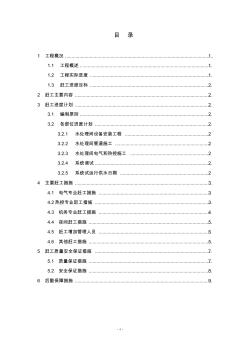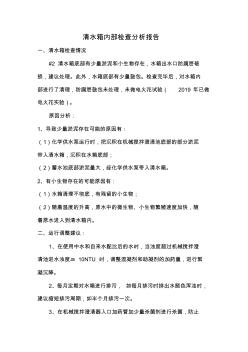电厂化学专业
电厂化学专业基本信息
| 中文名 | 电厂化学专业 | 专业代码 | 550311 |
|---|---|---|---|
| 一级学科 | 材料与能源大类 | 课程设置 | 化学理论基础、化工原理 |
| 修学年限 | 三年 | ||
专业核心课程与主要实践环节:化学理论基础、化工原理、仪器分析、电解工程、电镀工艺学、化学电源工艺学、电工学、水及废水处理工程、热力设备腐蚀与防护、热力设备水气化过程、电厂燃料及用油、环境监测评价、水及废水处理、金工实习、生产实习、课程设计(化工原理、电镀与化学电源)、毕业设计等,以及各校的主要特色课程和实践环节。
电厂化学专业造价信息
电厂、热力公司、企业自备电厂,从事生产过程中化学方面的生产工艺设计、废水处理、环境监测及生产运行管理等工作。
电镀、废水处理等的工艺设计能力、废水处理设备的操作维护能力、环境监测评价能力。
电厂化学专业常见问题
-
进口:美国哈希HACH、美国热电奥立龙ORION、Rosemount、瑞士梅特勒METTLE、瑞士SWAN、法国polymetron、德国iotronic等国产:北京华科仪、北京核工业、上海丽和、苏州...
-
1 化学废水集中处理现状 电厂的化学废水有经常性废水和非经常性废水两部分,2×600 MW机组的废水排放量如表1所示。 表1 化学废水排放量 500)this.style.width=500;&...
电厂废水处理、电镀工艺。
电厂化学专业文献

 电厂化学水赶工计划及措施
电厂化学水赶工计划及措施
-I- 目 录 1 工程概况 .................................................................................................................. 1 1.1 工程概述 ...................................................................................................... 1 1.2 工程实际进度 .............................................................................................. 1 1.3 赶工进度目标 .............................

 电厂化学清水箱检查分析报告
电厂化学清水箱检查分析报告
清水箱内部检查分析报告 一、清水箱检查情况 #2 清水箱底部有少量淤泥和小生物存在,水箱出水口防腐层破 损,建议处理。此外,水箱底部有少量鼓包。检查完毕后,对水箱内 部进行了清理,防腐层鼓包未处理,未做电火花试验( 2019 年已做 电火花实验)。 原因分析: 1、导致少量淤泥存在可能的原因有: (1)化学供水泵运行时,把沉积在机械搅拌澄清池底部的部分淤泥 带入清水箱,沉积在水箱底部; (2)蓄水池底部淤泥量大,经化学供水泵带入清水箱。 2、有小生物存在的可能原因有: (1)水箱清理不彻底,有残留的小生物; (2)随着温度的升高,原水中的微生物、小生物繁殖速度加快,随 着原水进入到清水箱内。 二、运行调整建议: 1、在使用中水和自来水配比后的水时,当浊度超过机械搅拌澄 清池进水浊度≥ 10NTU 时,调整混凝剂和助凝剂的加药量,进行絮 凝沉降。 2、每月定期对水箱进行排污, 如每月排污时排
《电厂化学专业英语》是普通高等教育“十二五”规划教材之一。
Chapter 1 Introduction to Power Plant Chemistry
1.1 Introduction of Steam Chemistry Systems
1.2 Main Contents of Power Plant Chemistry -
1.3 Chemistry Requirement for Power Plant
1.4 Feedwater and Boiler Water Treatment
Chapter 2 High-Purity Makeup Water Treatment
2.1 Introduction
2.2 Pretreatment
2.3 High-Purity Makeup Treatment Methods
2.4 Regeneration and Co-current/countercurrent Systems
2.5 Demineralizer Performance Calculations
2.6 System Design Calculations
2.7 Mixed-bed Polishing
2.8 Demineralizer Component Fundamentals
2.9 Packed-bed Demineralizers
2.10 Reverse Osmosis
2.11 Electrodialysis and Electrodialysis Reversal
2.12 Electrodeionization
Chapter 3 Corrosion and Prevention of Metal Materials
3.1 Introduction
3.2 Oxygen Corrosion in Thermal Devices
3.3 Acidic Corrosion of Thermal Devices
3.4 Stress Corrosion of Thermal Devices
3.5 Corrosion by Enriched Medium in Boiler
3.6 Corrosion and Prevention of Copper Alloy
3.7 Chemical Cleaning
Chapter 4 Condensate Feedwater Chemistry
4.1 Introduction
4.2 Condensate/Feedwater System Construction Materials
4.3 Condensate Chemistry Dissolved Oxygen
4.4 Mechanical Removal of Dissolved Oxygen and Other Gases
4.5 Chemical Control of Dissolved Oxygen
4.6 Flow-accelerated Corrosion
4.7 Copper Alloy Corrosion and Preventive Measures
4.8 Additional Corrosion Control Requirements
4.9 Oxygenated Treatment
4.10 Feedwater Chemistry Guidelines
4.11 Chemical Feed Systems
4.12 Monitoring and Control of Condensate Contaminants
4.13 Condensate Polishing and Treatment of Condensate
Chapter 5 Boiler Water Chemistry
5.1 Introduction
5.2 Drum-type Boiler Design
5.3 Once-through Steam Generation
5.4 Boiler Water Contamination
5.5 Boiler Water Treatment Programs
5.6 Phosphate Hideout
5.7 Alternative Phosphate and Nonphosphate Programs
5.8 Heat Recovery Steam Generation
Chapter 6 Steam Chemistry
6.1 Introduction
6.2 Primary Carryover Products
6.3 Mechanical Carryover
6.4 Vaporous Carryover
6.5 Solids Introduction by Contaminated Attemperator Water."
6.6 Superheater Exfoliation
6.7 Water Chemistry Limits to Prevent Steam Contamination by Carryover.
6.8 Boiler Water Chemistry Guidelines for Control of Steam Chemistry
6.9 Steam Chemistry Monitoring
6.10 Steam Chemistry Issues at Industrial Plants without Turbine
Chapter 7 Chemistry Sampling
7.1 Introduction
7.2 The Need for Sampling
7.3 Sample Point Selection
7.4 Cogeneration/Combined Cycle/Industrial Plant Sampling
7.5 Techniques to Obtain Representative Samples
7.6 Data Acquisition
Appendix I Glossary of Chemistry in Fossil/Nuclear Power Plant
Appendix II Glossary of Materials in Power Plant
References
《化学水处理系统和设备》共分十一章。
《化学水处理系统和设备》适用于火力发电厂化学专业人员的培训,也可供电力院校相关专业人员参考。
·查看全部>>
- 相关百科
- 相关知识
- 相关专栏
- 电厂化学专业英语
- 电厂化学设备检修
- 电厂标识系统KKS编码工程实施指南
- 电厂水化验员
- 电厂液压设备维修技术
- 电厂热力过程自动化
- 电厂热动力工程师
- 电厂煤耗节能计算:锅炉损失对凝汽式燃煤电厂供电煤耗的影响
- 电厂锅炉原理
- 电厂锅炉设备及运行维护
- 电厂锅炉运行监测与优化模型及应用
- 电压为690V及以下单速三相笼型感应电动机的起动性能
- 电压互感器负载箱
- 电压源换流器型高压直流输电换流站
- 电压源换流阀组件
- 电压继电器与保护装置
- 中高职衔接道路桥梁工程技术专业教学标准探索与实践
- 中国现行建筑专业图集
- 伊和乌素风电厂35kv配电室火灾应急处理演练方案
- 中国电工技术学会电力系统控制与保护专业委员会成立
- 中国电机工程学会高压专业委员会
- 在划分多种专业性作业条件下工程施工组织优化理论…
- 永城火电厂300MW机组给水泵驱动方式的优化选择
- 云南省建筑专业技术职务任职职称推荐评审表填写范例
- 电子信息工程专业实践教学体系的构建
- 土建工程检测专业人才培养体系
- 环境设计专业卓越工程师培养模式探析
- 中国城市规划协会规划展示专业委员会年会
- 增强水文与水资源工程专业本科生毕业实习效果的思考
- 在高校艺术设计专业开设民间艺术课程的教学实践
- 中国稀土学会专业委员会
- 园林专业园林植物遗传育种学教学改革的若干思考